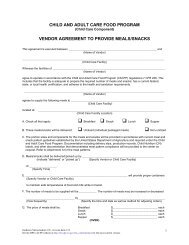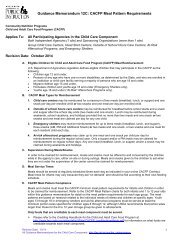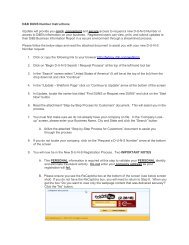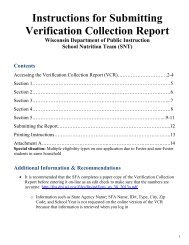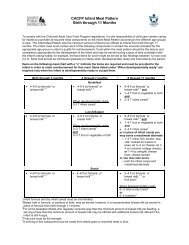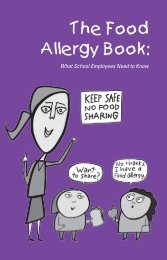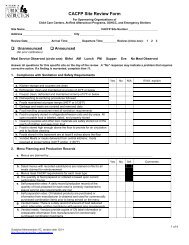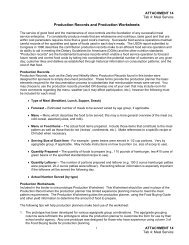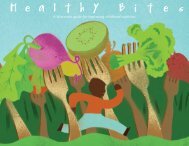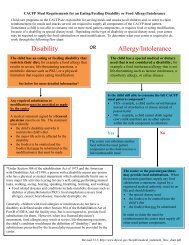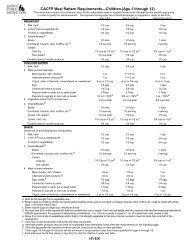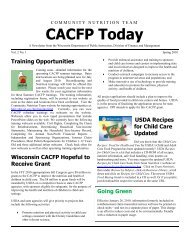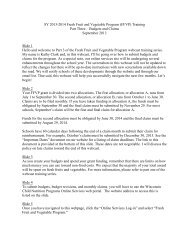‣ Trim away visible fat from meats and poultry before cooking. Remove theskin from chicken and turkey to reduce the amount of solid fats. Drain offany fat that appears during cooking.‣ Boil, grill, roast, poach, or boil fish, meat, or poultry instead of frying.These cooking methods do not add extra fat and calories. Keep in mind thatbreading adds extra calories, and frying causes food to soak up more fatduring cooking.‣ Limit serving highly processed poultry, fish, or meat (like hotdogs, chickennuggets, and fish sticks) to once weekly. Even “reduced-fat” meats andcold cuts, like sausage, bologna, and salami, may be high in solid fats,sodium, and calories. Use canned tuna or salmon (packed in water) forsandwiches in place of deli or lunch meats, which are often higher insodium.‣ Purchase canned beans, fish, and meat labeled “no salt added” or “lowsodium.” If these are not available, reduce sodium by draining and rinsingcanned foods before preparing. Choose fat-free refried beans or reducedsugarand reduced-sodium versions of baked beans.‣ See Choose MyPlate for additional ideas on lean choices for meat and meatalternates. http://www.choosemyplate.gov/food-groups/protein-foodtips.htmlBuild a Healthy Plate with Whole GrainsAny food made from wheat, rice, oats, cornmeal, barley, or cereal grain is a grainproduct. Bread, pasta, oatmeal, breakfast cereals, tortillas, and grits are examplesof grain-rich products. Grains are divided into two groups: whole grains andrefined grains. Whenever possible, whole-grain versions of these grain productsshould be offered. Most children 2 years and older do not consume enough wholegrains or other foods rich in dietary fiber. You can help by providing children witha variety of whole grains during the week. The Dietary Guidelines for Americansrecommend making at least half your grains whole grains. Increase the amount ofwhole grains in children’s diets by purchasing, preparing, and serving foods thatcontain a whole as the first ingredient in the ingredient list. Including whole-grainfoods in meals and as snacks can: Give children the B vitamins and minerals they need for energy to play andlearn. Promote proper digestion. Help them feel full longer and maintain a healthy weight as they grow. Add texture and flavor to their plate.30
What type of grains should I offer?Instead of: Choose Whole Grains:White rice Brown rice, wild rice, quinoaWhite flour Whole-wheat flourWhite or wheat bread 100% Whole-grain breadNoodles, pasta, spaghetti Whole-wheat pasta or whole-grain noodlesFlour tortillas Whole-grain or whole-corn tortillasCrackers Whole-grain crackersDegermed cornmeal Whole-grain cornmealHow can I tell whether a product is whole grain?‣ Take a look at the ingredient list. Choose products that name a whole-grainingredient first on the list, or second after water – that means there is moreof it than the other ingredients.‣ Look for “whole wheat,” “brown rice,” “oatmeal,” “bulgur,” “buckwheat,”“whole corn,” “whole-grain cornmeal,” “whole oats, “whole rye,” or “wildrice.” For foods made of multiple grains, make sure the whole-grainingredients appear near the beginning of the ingredient list.‣ Use the <strong>Nutrition</strong> Facts label to check the fiber content of whole-grainfoods. Choose those higher in dietary fiber. Good sources of fiber contain10% to 19% of the Daily Value; excellent sources contain 20% or more.‣ Remember: the color of a grain or bread product is not an indication that itis a whole-grain food. Bread can be brown because of molasses or otheradded ingredients. Foods labeled as “multi-grain,” “stone-ground,” “100%wheat,” “cracked wheat,” “seven-grain,” or “bran” are usually not wholegrainproducts, and might not contain any whole grain.How can I limit added sugars and solid fats when serving whole-grain foods?‣ Check the ingredient list of whole-grain rich products for added sugars.Look for sugar, honey, and ingredients ending in “-ose.” If present, makesure they are not one of the first three ingredients on the ingredient list. Fora naturally sweet taste, try topping whole-grain foods with fresh, frozen, orcanned fruit slices (canned in 100% fruit juice or water).‣ Be aware of solid fats in grain foods and toppings by reading the ingredientlist. Instead of butter, shortening, lard and oils with the word“hydrogenated” in the ingredient list, choose those made from vegetableoils that are not hydrogenated.‣ Choose toppings wisely for toast, hot cereals, pasta, noodles, and rice.Instead of adding butter, stick margarine, lard, bacon, cream sauces, andregular, full-fat cheese, use vegetable oils, low-fat cheeses, marinara sauce,or steamed vegetables as toppings.Build a Healthy Plate with Milk<strong>Child</strong>ren who consume dairy products such as milk, milk substitutes, yogurt, andcheese get many important nutrients and have healthier diets than those who don’t.However, many children ages 2 to 3 years, and most children 4 years and older, do31
- Page 1 and 2: The Summer Food Service ProgramSumm
- Page 3 and 4: CONTENTSINTRODUCTION ..............
- Page 5 and 6: Using a Food Thermometer ..........
- Page 7: DietaryGuidelines forAmericansThe D
- Page 10 and 11: FOOD COMPONENTS AND FOOD ITEMSSUMME
- Page 12 and 13: Offer VersusServe (OVS)Offer versus
- Page 14: More on FoodComponentsThis section
- Page 17 and 18: For lunch and supper, 8 oz. or 1 cu
- Page 19 and 20: ProductFormulationSchool Foodservic
- Page 21 and 22: Summer Menu PlanningIn this section
- Page 23 and 24: CalculatingServing Sizesand CostsCh
- Page 25 and 26: Sample Cycle MenusThe following is
- Page 27 and 28: Making the Most of Summer MealsBuil
- Page 29 and 30: fruits are naturally sweet, it can
- Page 31: Protect children’s hearts, brains
- Page 35 and 36: Prepare a stir-fry with a variety o
- Page 37 and 38: SampleRecipesThe following recipes
- Page 39 and 40: 2 ¼ tsp Salt-free chili-lime seaso
- Page 41 and 42: Education and EnrichmentIn this sec
- Page 43 and 44: The Physical EnvironmentIf you are
- Page 45 and 46: PromotingPhysicalActivityWhile phys
- Page 47 and 48: Spotlight on Summer Food Service Pr
- Page 49 and 50: amounts of foods that will meet the
- Page 51 and 52: PART II — NUTRITION SERVICESHire
- Page 53 and 54: Getting Organized: Food Purchasing
- Page 55 and 56: DevelopingFoodSpecificationsWhen pr
- Page 57 and 58: How to Use theFood BuyingGuideUSDA'
- Page 59 and 60: Additional information about calcul
- Page 61 and 62: MenuProductionRecordsThe SFSP regul
- Page 63 and 64: ScoopsThe number of the scoop indic
- Page 65 and 66: Keep Food Fresh: Food StorageIn thi
- Page 67 and 68: Drive Dirt and Germs Out: Food Sani
- Page 69 and 70: Take Precautions: Food SafetyIn thi
- Page 71 and 72: SEPARATESeparate foods that are rea
- Page 73 and 74: For additional information, visitht
- Page 75 and 76: Call the local or State Health Depa
- Page 77 and 78: E. Coli ReportAccording to USDA's F
- Page 79 and 80: Minimum Safe Internal Temperatures
- Page 81 and 82: Approximate Storage Life in Days of
- Page 83 and 84:
e Will harden at high temperature,
- Page 85 and 86:
Frozen Food Storage (continued)The
- Page 87 and 88:
f Garlitz, Carol J., Boor, K., and
- Page 89 and 90:
Food Safety ChecklistDate__________
- Page 91 and 92:
Food Safety Checklist, continuedFOO
- Page 93 and 94:
Questions and Answers1. I have to h
- Page 95 and 96:
with food safety information, which
- Page 97 and 98:
MyPlateThe U.S. Department of Agric
- Page 99 and 100:
meal. Example: An orange and orange
- Page 101 and 102:
GROUP DMINIMUM SERVING SIZE FOR GRO
- Page 103 and 104:
How to Read Nutrition LabelsNutriti
- Page 105 and 106:
3. Limit these nutrientsIn general,
- Page 107 and 108:
Food Sources of Vitamin A (Continue
- Page 109 and 110:
Food Sources of Vitamin C (Continue
- Page 111 and 112:
Food Sources of Vitamin C (Continue
- Page 113 and 114:
Food Sources of Iron (Continued)Foo
- Page 115 and 116:
Food Sources of CalciumAll foods li
- Page 117 and 118:
Serving Sizes and Yields for Vegeta
- Page 119 and 120:
Serving Sizes and Yields for Fruits
- Page 121 and 122:
e of the Position:Sample Position D
- Page 123 and 124:
Food Service Equipment NeedsEquipme
- Page 125 and 126:
Quaternary ammonium compounds (Quat
- Page 127 and 128:
Sanitize Smallware in a Mechanical
- Page 129 and 130:
CAUTION:All equipment should be kep
- Page 131 and 132:
Food Inventory Record InstructionsT
- Page 133 and 134:
Date Marking Ready-to-Eat, Potentia
- Page 135 and 136:
DAILY TEMPERATURE FORM - INTERNAL F
- Page 137 and 138:
RESOURCE SECTIONInformation Resourc
- Page 139 and 140:
Nutrition.govNIFANCEMCHAdditional o
- Page 141 and 142:
Serving It Safe: A Manager’s Tool



